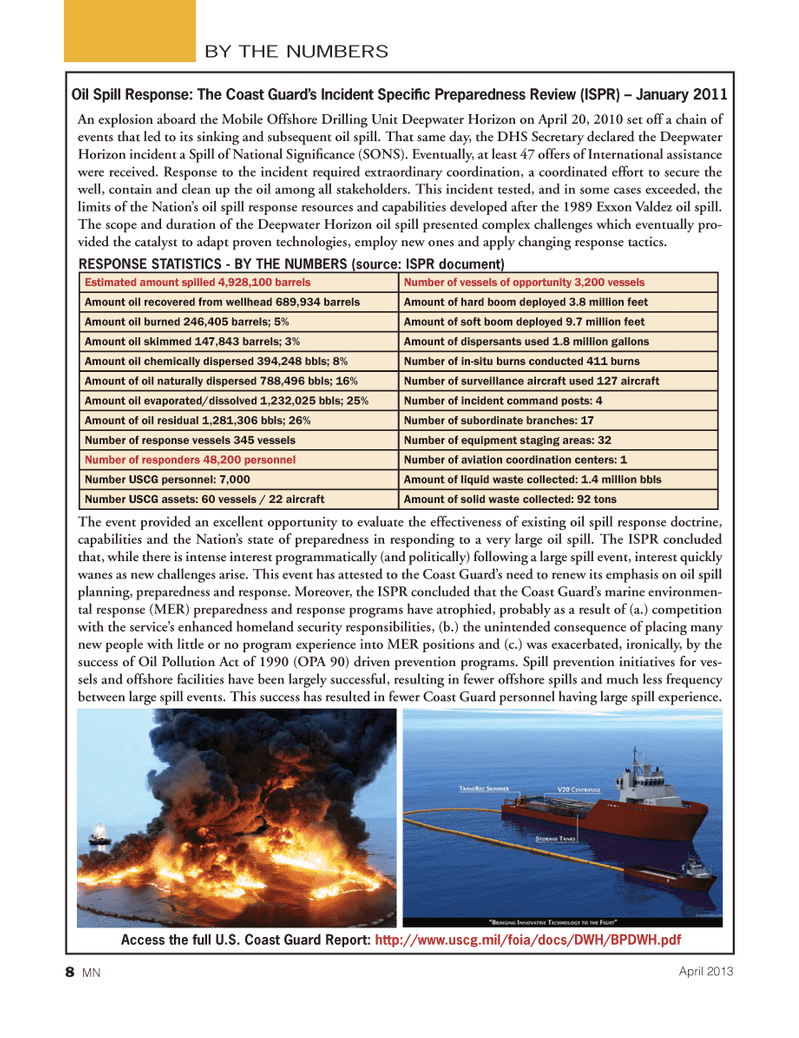
Page 8: of Marine News Magazine (April 2013)
Offshore Service Operators
Read this page in Pdf, Flash or Html5 edition of April 2013 Marine News Magazine
Oil Spill Response: The Coast Guard?s Incident Speci c Preparedness Review (ISPR) ? January 2011 An explosion aboard the Mobile Offshore Drilling Unit Deepwater Horizon on April 20, 2010 set off a chain of events that led to its sinking and subsequent oil spill. That same day, the DHS Secretary declared the Deepwater Horizon incident a Spill of National SigniÞ cance (SONS). Eventually, at least 47 offers of International assistance were received. Response to the incident required extraordinary coordination, a coordinated effort to secure the well, contain and clean up the oil among all stakeholders. This incident tested, and in some cases exceeded, the limits of the NationÕs oil spill response resources and capabilities developed after the 1989 Exxon Valdez oil spill. The scope and duration of the Deepwater Horizon oil spill presented complex challenges which eventually pro- vided the catalyst to adapt proven technologies, employ new ones and apply changing response tactics. The event provided an excellent opportunity to evaluate the effectiveness of existing oil spill response doctrine, capabilities and the NationÕs state of preparedness in responding to a very large oil spill. The ISPR concluded that, while there is intense interest programmatically (and politically) following a large spill event, interest quickly wanes as new challenges arise. This event has attested to the Coast GuardÕs need to renew its emphasis on oil spill planning, preparedness and response. Moreover, the ISPR concluded that the Coast GuardÕs marine environmen- tal response (MER) preparedness and response programs have atrophied, probably as a result of (a.) competition with the serviceÕs enhanced homeland security responsibilities, (b.) the unintended consequence of placing many new people with little or no program experience into MER positions and (c.) was exacerbated, ironically, by the success of Oil Pollution Act of 1990 (OPA 90) driven prevention programs. Spill prevention initiatives for ves- sels and offshore facilities have been largely successful, resulting in fewer offshore spills and much less frequency between large spill events. This success has resulted in fewer Coast Guard personnel having large spill experience. Estimated amount spilled 4,928,100 barrels Number of vessels of opportunity 3,200 vessels Amount oil recovered from wellhead 689,934 barrelsAmount of hard boom deployed 3.8 million feet Amount oil burned 246,405 barrels; 5%Amount of soft boom deployed 9.7 million feet Amount oil skimmed 147,843 barrels; 3% Amount of dispersants used 1.8 million gallons Amount oil chemically dispersed 394,248 bbls; 8%Number of in-situ burns conducted 411 burns Amount of oil naturally dispersed 788,496 bbls; 16%Number of surveillance aircraft used 127 aircraft Amount oil evaporated/dissolved 1,232,025 bbls; 25%Number of incident command posts: 4 Amount of oil residual 1,281,306 bbls; 26% Number of subordinate branches: 17 Number of response vessels 345 vessels Number of equipment staging areas: 32 Number of responders 48,200 personnel Number of aviation coordination centers: 1 Number USCG personnel: 7,000Amount of liquid waste collected: 1.4 million bbls Number USCG assets: 60 vessels / 22 aircraft Amount of solid waste collected: 92 tons BY THE NUMBERSRESPONSE STATISTICS - BY THE NUMBERS (source: ISPR document) Access the full U.S. Coast Guard Report: http://www.uscg.mil/foia/docs/DWH/BPDWH.pdf 8 MNApril 2013MN April2013 Layout 1-17.indd 8MN April2013 Layout 1-17.indd 84/3/2013 9:58:28 AM4/3/2013 9:58:28 AM

 7
7

 9
9
